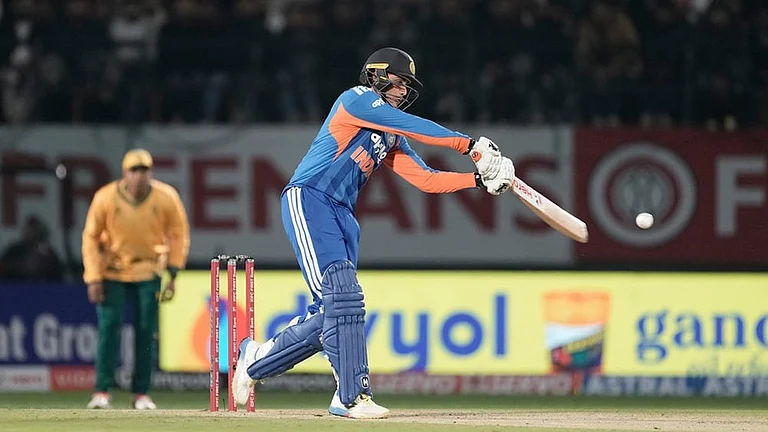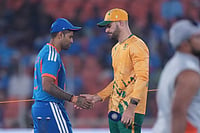THIS is supposed to be a pensioners' paradise. An old, laidback city where things move at their own, leisurely pace quite unlike that monstrous metropolis across the Sahyadri; where all its senior denizens do is dig their dentures deep into the Shrews-bury biscuits from Kayani's bakery.
Yet, this is a place crackling with activity. Here, in the thickets of Pune University—where the Centre for Development of Advanced Computing (C-DAC) is nestled—400 of the country's best and brightest engineers, crunching nothing but numbers and chips, have made God's Own Country eat humble pie.
By building a supercomputer that can perform 100,000,000,000 mathematical operations per second, with components bought literally off the shelf! Which, if needed, can be 'scaled' to work 10 times faster.
What's so great about it? 10 years ago, the US refused to sell India a second supercomputer, a less powerful Cray-XMP, fearing we might divert it for nuclear weapons research. The first one, an XMP-14, had been sold on condition that it be used for weather forecasting only under Uncle Sam's eagle eye.
"What the hell?" said Rajiv Gandhi. "Why can't we make it?" "Yeah," chimed in his energy secretary K.P.P. Nambiar, and turned to Vijay P. Bhatkar, an electrical engineer he'd come to trust during his stint at the Kerala State Electronics Corporation, Keltron: "Can we do this?"
Yo! In the 10 years since, Bhatkar and his team—none of whom had 'seen' a super-computer before—have made 35 such machines. On March 28, they unveiled PARAM 10000, India's most powerful, Asia's second fastest, six months ahead of schedule. "We've dissolved India's vulnerability in supercomputing," says Bhatkar. "Great nations aren't built on borrowed technology."
What does it do? Taller than those super-tall refrigerators, C-DAC's newest gizmo is a 100 giga-flop machine. Meaning, it can do 100,000,000,000 floating point operations per second; a flop is the addition of two large decimal numbers. Only the US and Japan have machines that can perform faster: a tera-flop machine.
Yet, you can't type a letterhead or run Windows '95 on PARAM 10000. Hell, you can't play Solitaire on it. Those are tasks for conventional computers, which solve problems by performing instructions one at a time in strict sequential order.
PARAM is built for bigger tasks. It works on the principle that if a single computer takes 'X' amount of time to perform a function, 100 computers should take 'X/100' of the same time to perform the same function. A bunch of microprocessors split the task and do "parallel
processing" at lightning speed.
How fast is it? PARAM 8600, an early model C-DAC supplied to the meteorological department, could do an 80-level analysis of the day's weather in 55 minutes. The American Cray could do it in 25 minutes; 15 minutes if clubbed with another Cray. PARAM 10000 can do the job in 3 minutes 40 seconds.
But with the BJP in power, and the threatening noises from across the border, it's PARAM's military possibilities that have hogged the headlines. According to C-DAC advisor Group Capt. M.M. Sharma:
How did they do it? C-DAC's hardware whiz, chief technical officer P.R. Eknath admits they haven't achieved a major scientific breakthrough; merely accomplished a complex technological exercise. But the fact they have done so, sans any collaboration, he says, is a tribute to our desi genius. When C-DAC first made PARAM 8000 and 8600, the US had hiked the upper limit for computing power that could be imported into India to 7000 MTops (mega theoretical operations per second). This February, the upper limit for India and 50 other countries was suddenly reduced to 2000 MTops. Fortunately for C-DAC, Sun Microsystems had shipped its Ultra-Sparc chips meant for PARAM 10000 in mid-January.
C-DAC could have ordered the chips well in advance for the March 28 deadline. But, says Eknath, that would have defeated the whole purpose of the supercomputer.
"We could have ordered Sun's chips in 1996 or 1997," he says. "But in the computer industry, computing power doubles every one-and-a-half years. We consciously waited till the last possible moment. For the same cost, we have double the power now. It's a game, it's a gamble."
Eknath & Co were wiring up PARAM till four hours before its launch. When Bhatkar commented that the machine would look lifeless when it was up and running, they hit upon a brainwave to instal LED (light-emitting diodes) on each of the 24 nodes to show the level of activity in each.
Says N. Vittal, chairman, PSEB: "C-DAC has a core of great people. All we need to do than Rs 50 crore, India's brought down prices of equivalent international machines so drastically that American majors like Silicon Graphics-Cray, IBM and HP are reported to be "dumping" their products here, much below the marked prices. "If they want to kill us, they're prepared to sell at 1/20th the price," says Eknath.
What next? Having won the technology sweepstakes, C-DAC is facing bureaucratic hurdles: its bid to sell a multi-million dollar computer system for power grid management was stalled by the World Bank which insisted that only firms with experience in installing 5000 MW plants and an annual turnover of Rs 100 crore could bid.
But PARAM 10000 benefits lie closer home. It offers a way out of the techno-logjam India and 50 other countries find themselves in vis-a-vis the US. Currently, all high-performance computers whose computing power exceeds 2000 MTops require clearance from the US Department of Commerce.
Indigenous technology is one way of not being saddled with obsolete stuff. C-DAC's Ajit Karnik says after all the diplomatic dilly-dallying with Washington over the first Cray, all India got was a low-end supercomputer: "Once you rely on borrowed technology you'll always be saddled with obsolete stuff."
Is it really so good?Critics say they can't understand the fuss and publicity over C-DAC's new machine when the US has machines that work 10 times faster. But its top brass say they've delivered what they promised: a giga-flop machine with a tera-flop architecture. "Converting a giga-flop into a tera-flop is just a matter of pumping in more money and adding more power. If some user wants us to do it, we will," they say. Bhatkar says a tera-flop requires at least Rs 200 crore which C-DAC doesn't have.
Is it really so useful?Critics also say PARAM doesn't facilitate porting of software. Whoever buys the machine will have to write his own software. Which is why, they say, not many industries have developed around PARAM. But C-DACers say even at the best of times, supercomputing is a very thin segment of the IT industry. (One reason why Bill Gates is not in it.) The end-users are faceless heavyweights like ISRO, ONGC,DRDO and the meteorology department.
But Bhatkar—who expects PCs to cost as little as CTVs soon—is aware of the need to take PARAM to the common man. He wants to combine the best features of a computer with those of a telephone to create a cheap and efficient communications system.
Step one is enabling every engineering college student to log on to PARAM. Step two is to the Internet voice-based and available on the telephone. It won't be a full-fledged computer, just a small display and keyboard (a little like France's MiniTel) on which you can send messages, receive voice mail and teletext, and browse.
And finally:By denying what India wanted, the Americans have unleashed a rat-race among the four organisations asked to build 'supers'—C-DAC, Defence Research and Development Org-anisation, Bhabha Atomic Research Centre, and the National Aeronautical Laboratory.
DRDO's 30 giga-flop machine—16 times faster than Pace-32 developed by NAL—was slated to be unveiled in August this year.But C-DAC has pipped it at the post.
Moreover, the Americans have unwittingly encouraged what they did not want India to do: barring C-DAC, all other players are said to be developing supers mostly for defence needs. But mercifully for the Americans, inter-organisation coordination between the four is conspicuously absent.Pushed to the wall, who knows what we can come up with next?






















